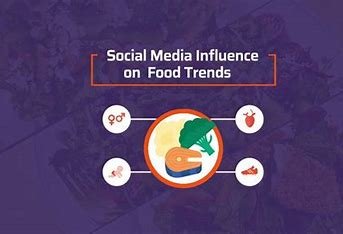
📲 What Is Influencer Culture in the Food World?
Influencer culture refers to the phenomenon where individuals with large social media followings (on platforms like Instagram, TikTok, YouTube, etc.) shape trends, opinions, and buying decisions through content creation. In the food world, influencers include:
- Home cooks
- Professional chefs
- Nutritionists
- Fitness personalities
- Celebrities
- Even everyday users who go viral with unique food content
They influence their audience by sharing recipes, diet advice, product reviews, food challenges, and aesthetic food photography.
🔥 1. Viral Recipes Spark Global Trends
One of the biggest ways influencers shape food trends is by posting viral recipes—quick, creative, and often visually striking meals that catch on like wildfire.
Examples:
- Dalgona coffee during the COVID-19 lockdown
- Baked feta pasta that caused feta shortages in some countries
- Nature’s cereal (fruit + coconut water + ice) promoted by Lizzo
- Birria tacos, ramen hacks, or cloud bread on TikTok
These recipes spread rapidly through hashtags, reposts, and trends like “FoodTok” or “Insta recipes,” often reaching millions of users in hours or days.
🌱 2. Endorsing Niche Diets and Health Trends
Many influencers use their platforms to promote specific diets or eating lifestyles, turning once-niche approaches into mainstream movements. For example:
- Veganism and plant-based diets (popularized by influencers like Tabitha Brown or Earthling Ed)
- Keto and low-carb diets
- Paleo, gluten-free, or intermittent fasting
- “Clean eating” or intuitive eating
These diets are often shared through:
- “What I eat in a day” videos
- Grocery hauls
- Meal prep tutorials
- Diet challenges (e.g., “Whole30,” “Vegan for a week”)
Followers trust influencers’ personal experiences, especially when paired with fitness or beauty content, which adds credibility and makes these diets feel aspirational.
📸 3. Promoting Aesthetic and Instagrammable Meals
Social media food culture thrives on visual appeal. Food influencers prioritize how food looks almost as much as how it tastes. This has led to:
- The rise of smoothie bowls, rainbow lattes, sushi stacks, over-the-top milkshakes, and charcuterie boards
- Increased use of vibrant, colorful ingredients (like dragon fruit, edible flowers, activated charcoal, or matcha)
- Creative presentation styles (e.g., bento box lunches, geometric cakes, or layered drinks)
These eye-catching dishes are designed to be shared online, encouraging viewers to recreate and post their own versions, which reinforces the trend’s popularity.
🛒 4. Influencing Consumer Behavior and Food Marketing
Influencers are now as powerful as traditional advertising when it comes to driving consumer food choices. Their content can:
- Sell out products (e.g., Trader Joe’s items, viral condiments, kitchen gadgets)
- Create demand for unusual or imported ingredients (like gochujang, tahini, or black garlic)
- Promote new food brands or fast food menu items through partnerships or sponsored posts
Many influencers now collaborate with brands to create food products, such as:
- Emma Chamberlain’s coffee brand
- MrBeast’s burger chain
- Tabitha Brown’s vegan products at Target
These collaborations blend personal branding with product marketing in a way that feels authentic and engaging to their followers.
🌍 5. Making Global and Cultural Foods Mainstream
Influencer culture has also helped shine a spotlight on global cuisines, helping introduce people to foods from different cultures in an accessible way.
Examples include:
- Korean food (bulgogi, kimchi, Korean corndogs)
- Filipino dishes (ube, lumpia, adobo)
- Middle Eastern food (hummus, shakshuka, falafel)
- African cuisine (jollof rice, egusi soup)
Creators from diverse backgrounds share family recipes and cultural traditions, giving these foods visibility that was once limited in mainstream Western media.
🧠 6. Creating a Mind-Body-Food Connection
Food influencers often go beyond recipes and talk about the relationship between food, health, mental wellness, and self-image. Many promote:
- Mindful eating
- Food as self-care
- Body-positive approaches to nutrition
- Balancing indulgence with health goals
This shift has changed how people think about food—not just as fuel or enjoyment, but as part of identity, lifestyle, and well-being.
⚖️ 7. Challenges and Criticisms of Influencer-Driven Food Culture
While there are many positives, there are also some drawbacks:
❗ Misinformation:
- Not all influencers are trained in nutrition or food safety.
- Trendy but unhealthy or unbalanced diets can be promoted as “miracle” solutions.
❗ Unsustainable Trends:
- Viral food trends often lead to food waste, supply shortages, or overconsumption of single ingredients (like avocados or oat milk).
❗ Pressure and Perfectionism:
- Constant exposure to “perfect” food and bodies can cause anxiety, disordered eating, or unrealistic expectations around food and health.
✅ Conclusion: A Cultural Revolution in How We Eat
Influencer culture has reshaped the food landscape by:
- Turning everyday meals into social content
- Making food trends more interactive and participatory
- Blurring the line between food, lifestyle, and identity
Whether it’s starting your day with a TikTok-inspired breakfast or trying a trending ingredient you saw on Instagram, the way we cook, eat, and talk about food has become more digital, dynamic, and community-driven—all thanks to the powerful voices of online influencers.
